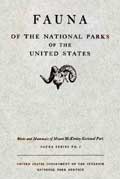.gif)
MENU
|
Fauna of the National Parks — No. 3
Birds and Mammals of Mount McKinley National Park |

|
Birds
DESCRIPTIONS OF BIRD SPECIES
NORTHWESTERN SHRIKE
Lanius borealis invictus [GRINNELL]
GENERAL APPEARANCE.—A bird about the size of a robin with raptorial habits. The strong black bill is notched and plainly hooked at the end. This bird has a black band through the eye. The head and upper parts are clear gray while the outer tail feathers are strongly edged with white which shows plainly when the bird is in flight. Length, 10.32 inches.
IDENTIFICATION.—Good field characters for the shrike are its coloration which is pronounced black, gray, and white; its method of perching upright on barren exposed dead limbs and tree tops, and its direct bullet-like flight. The large size of this bird and the fine wavy dark lines across the breast and under parts distinguish the Northwestern shrikes from the smaller shrikes breeding in the United States.
DISTRIBUTION.—It breeds from Mount McKinley and northwestern Alaska south to northern British Columbia, Alberta, and Saskatchewan. It is found throughout the McKinley region, being most abundant at or near timber line.
HABITS.—Charles Sheldon noted the earliest spring arrival of this bird on the Toklat on April 26, 1908. In May 23, 1926, in Savage River Canyon we saw a shrike vigorously attack and pursue a magpie. On June 10, 1926, I shot a male Northwestern shrike that flew by carrying some large object in its claws. One shot pierced the shrike's brain so that it fell headlong, rolling over and over on the ground, but it still rigidly grasped the prey in its claws, which upon examination proved to be—not a mouse—but a fledgling robin which the shrike had evidently stolen out of the robin's nest, for it was too young to fly.
On June 22 at Savage River foothills a family of young shrikes just learning to fly was noted by Wright. They hovered over various objects and kept calling back and forth to each other. On July 1 a family of four fearless young shrikes was noted, and on July 10, 1926, a family of six young shrikes which were well able to fly was noted at Igloo Creek.
In 1932 I found shrikes about twice as numerous as they had been in 1926, and following the breeding season large families consisting of from four to six young shrikes were frequently seen in the late summer.
This species is a common breeding bird in the McKinley region where it is one of the earliest spring arrivals.
NEXT >>>
 Top
Top
Last Modified: Thurs, Oct 4 2001 10:00:00 pm PDT
http://www.cr.nps.gov/history/online_books/fauna3/fauna9j10.htm
![]()
